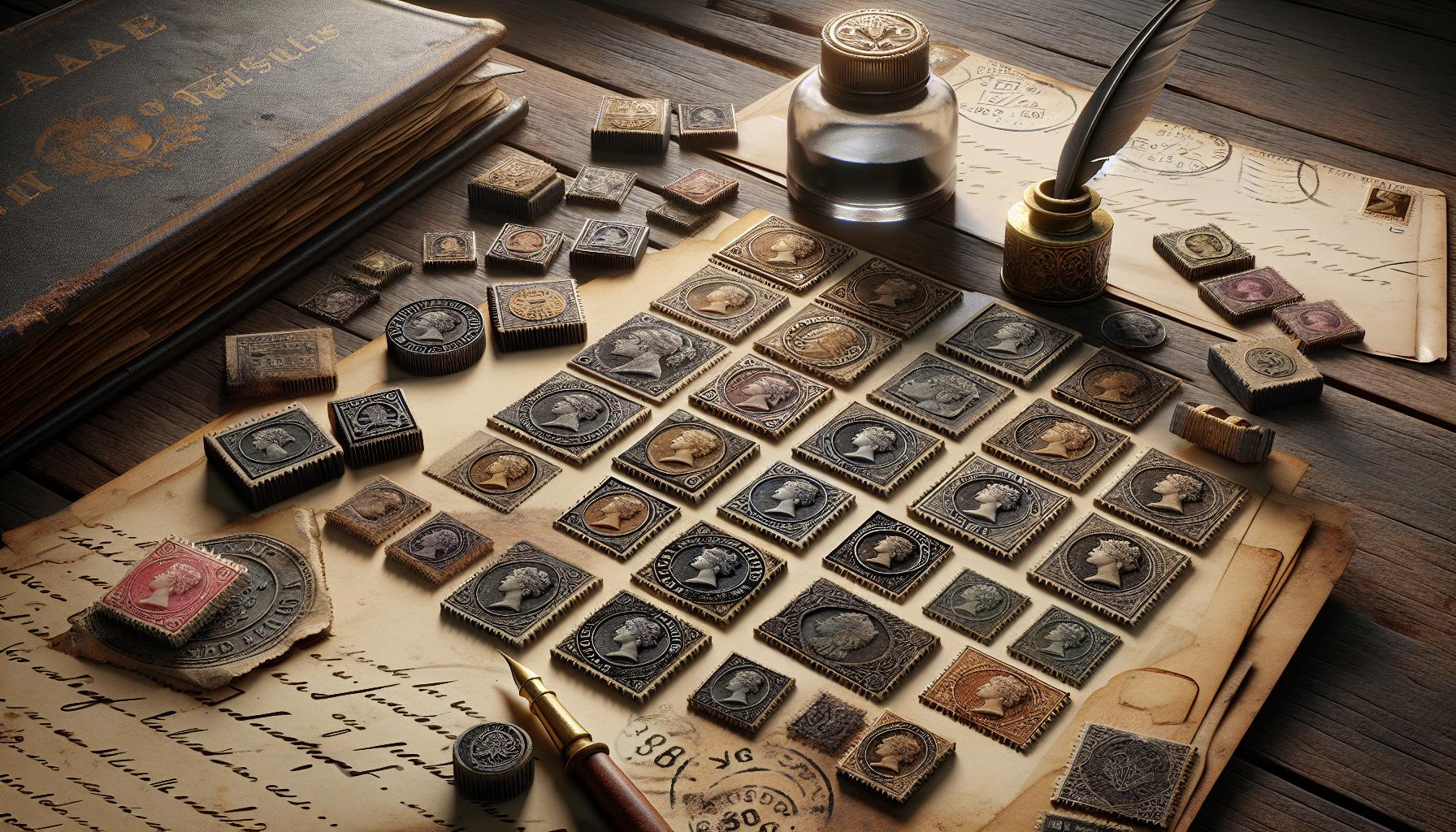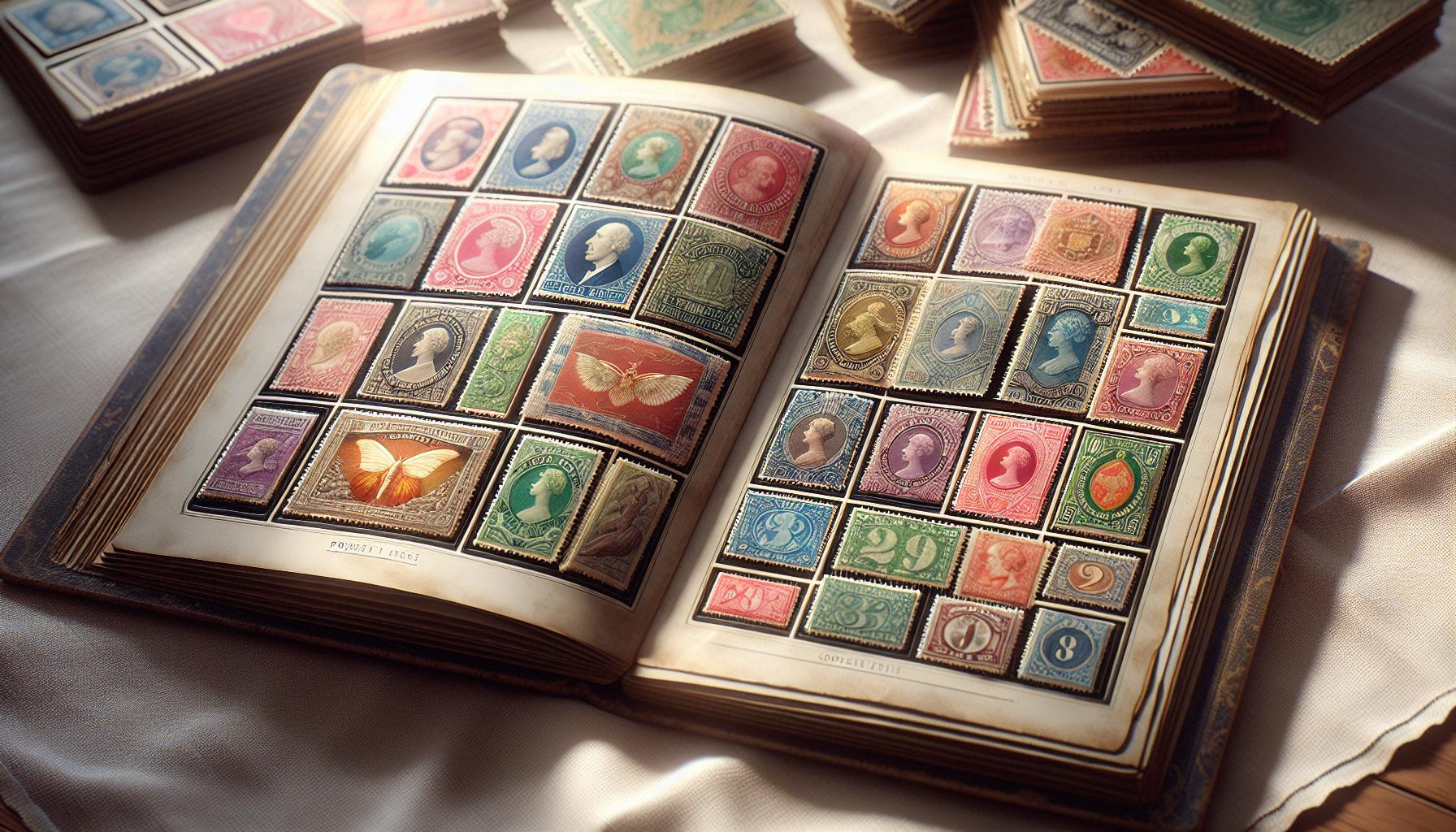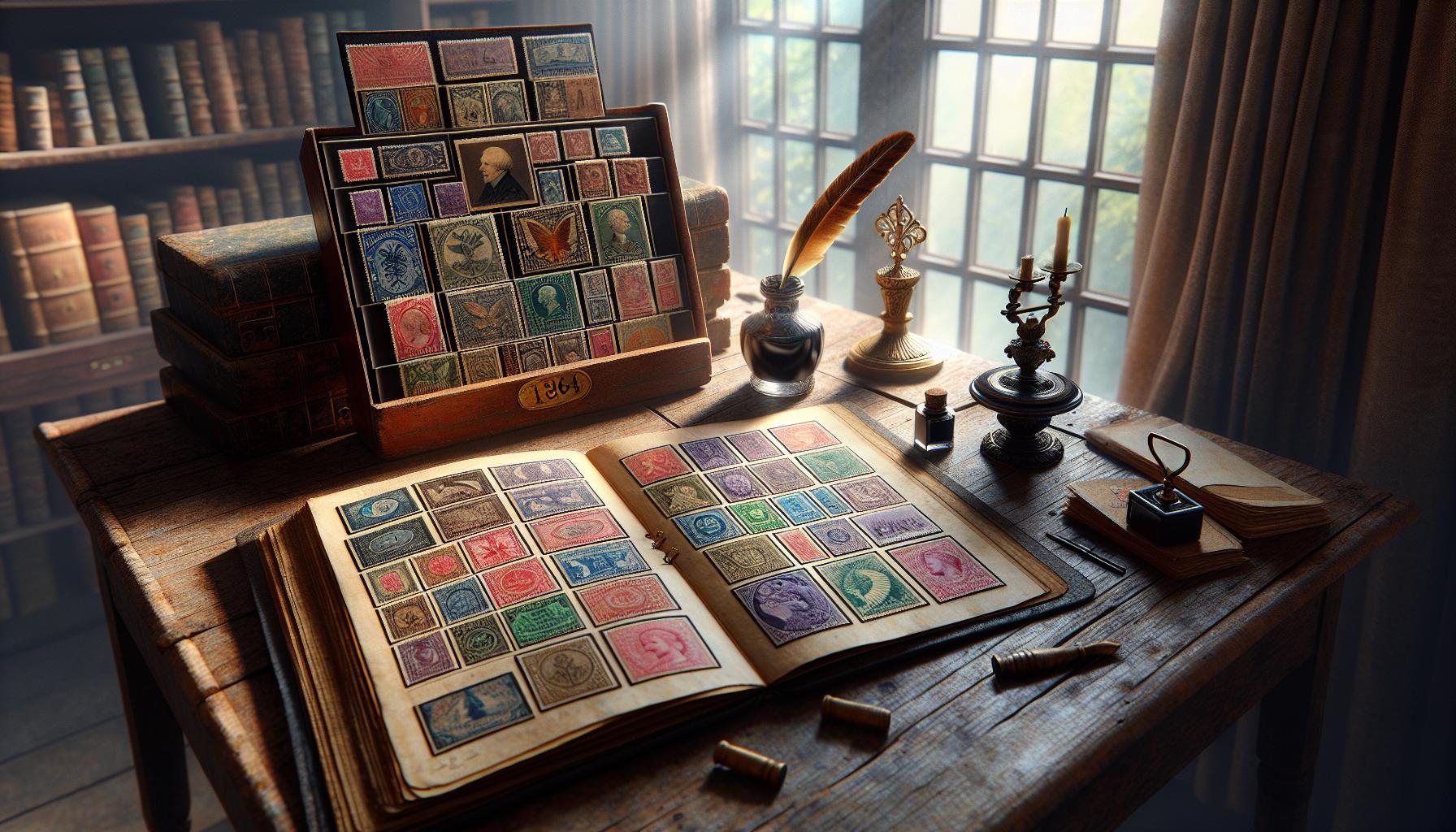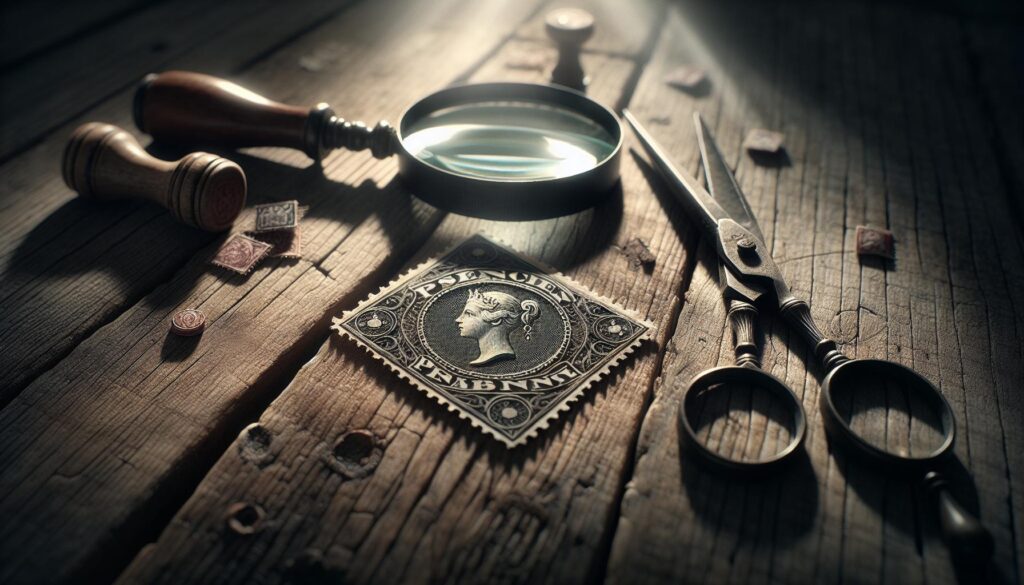Philately, the art of collecting and studying postage stamps dates back to the mid-19th century.
As I explore this hobby more deeply, I uncover tales of ancient postal services and the evolution of communication. Each fact is a surprise, revealing the stories behind the stamps and the people who cherished them.
Join me on this journey of discovery, where every stamp holds a treasure trove of knowledge, ready to be shared and celebrated with friends.
Introduction
The origins of philately began in the mid-19th century and have since charmed collectors worldwide. The joy of collecting stamps stems from the pleasure of collecting stamps and the stories they tell.
Definition and Scope
Philately refers to the study and collection of postage stamps and postal history. Georges Herpin coined the term in 1864, combining the Greek words for “friend” and “exempt from taxes.”
This definition encompasses various activities, including studying stamps’ design, production methods, and communication roles.
What is Philately?
Philately is more than just collecting stamps; it’s an exploration of postal history and the evolution of communication methods.
While many collectors focus on regular postage stamps, some pursue unique issues issued by governments, local posts, or forgers. Collectors enjoy connecting their interests to others’ collections, sharing their mutual passions for philatelic adventures.
Importance of Philately in Postal History
Philately plays a crucial role in understanding postal services’ history. It offers insights into how communication and commerce evolved.
By studying stamps, collectors can see past societies, cultures, and technological changes. Each stamp represents a specific time and place and carries the weight of historical significance, connecting us to history.
The Birth of Modern Philately

Early Postal Systems
Before modern postage stamps, sending letters involved a complicated system where the recipient paid for delivery. International messages bounced around like a game of hot potato.
The 19th century saw the rise of national postal services, providing more reliable and accessible communication across Europe and beyond.
Universities in England and Italy established postal systems as early as the 13th century, serving students away from home and laying the foundation for nationwide postal networks.
The Penny Black Revolution
The Penny Black stamp, released in 1840, changed everything. This iconic stamp is often called the world’s first adhesive postage stamp.
It introduced pre-paid postage, making sending letters simple. Collectors fawn over this gem for its historical significance and design. Its introduction sparked a frenzy of stamp collecting, igniting a love for philately.
Sir Rowland Hill’s Postal Reforms
Sir Rowland Hill played a pivotal role in shaping modern postal services. His innovative reforms improved the efficiency and affordability of mail delivery.
Hill proposed the pre-paid system that paved the way for postage stamps, enabling anyone to send a letter without securing payment from the recipient.
His vision revolutionized communication and how people experienced and cherished the art of collecting stamps.
Emergence of Stamp Collecting

The fun world of stamp collecting burst onto the scene in the mid-19th century, all thanks to the game’s first player: the postage stamp.
The 1840 debut of the Penny Black in England pushed the boundaries of how we sent letters and opened the floodgates for hobbyists everywhere.
People got hooked, and suddenly, collecting stamps wasn’t just for the curious; it became a worldwide phenomenon.
Pre-Stamp Collecting Activities
Before postage stamps made their grand entrance, collectors dabbled in postal-related curiosities. Take John Bourke from Ireland, for example.
He pieced together a book full of embossed revenue stamps long before the Penny Black graced the market. Though these collecting activities lacked official recognition as a hobby, they laid the groundwork for the excitement that philately would bring.
John Edward Grey: The First Recognized Stamp Collector
Regarding the first official stamp collector title, there’s no better candidate than John Edward Grey, a British zoologist.
He didn’t just collect stamps; he made history by snapping up four of them on the first day the Penny Black went up for grabs. His enthusiasm set the stage for a new era of stamp collecting, showing that these little pieces of paper could hold vast historical significance.
Early Collectors and Their Motivations
Early stamp collectors found themselves driven by varying motivations. Some saw stamps as miniature works of art, while others embraced the thrill of the hunt. The joy of discovering a rare gem or completing a collection brought satisfaction akin to uncovering hidden treasure. As the hobby flourished, collectors built networks, sharing their finds and stories, creating a rich community centered around a shared passion for philately.
Stamp collecting isn’t just about the stamps; it’s about the journey of exploration and the connections we forge along the way. Each stamp tells a story, a slice of history waiting to be appreciated and celebrated.
Coining the Term “Philately”

Georges Herpin’s contribution in 1864 laid the foundation for what we now recognize as philately. He aimed to provide a sophisticated name for stamp collecting, a hobby that had gained substantial traction, distinguishing it from earlier, less appealing terms.
Georges Herpin and the Term’s Creation in 1864
In 1864, Herpin stepped up to coin the term “philately” in his Le Collectionneur de Timbres-poste article. He was frustrated by the existing names, such as “timbromanie,” which roughly translates to “stamp mania.”
By introducing “philately,” he gave this pastime a significant identity, allowing enthusiasts to unite under a common banner. This act marked a turning point in people’s perception and engagement with stamp collecting.
Etymology and Meaning
Herpin crafted “philately” by blending Greek roots. The first part, “philo,” means attraction or affinity. The second, “ateleia,” translates to exemption from taxes.
This etymology emphasizes that stamp collectors genuinely love stamps and reflects the core joy of bypassing postal fees. So, every time I marvel at a beautifully crafted stamp, I’m not just collecting but engaging in a tradition steeped in appreciation and history.
Development of Philately as a Hobby
Stamp collecting flourished after the introduction of the Penny Black. This first postage stamp, released in 1840, revolutionized mail delivery and sparked widespread interest in collecting.
By 1846, reports indicated that collectors in England began amassing stamps. Initially used for varied purposes, like adorning wallpaper, stamps soon became sought-after treasures.
Early Philatelic Societies

Philatelic societies arose as stamp collectors united over their shared passion. These societies provided platforms for collectors to exchange insights and expand their collections.
In 1869, the Royal Philatelic Society London emerged as the world’s oldest philatelic society, paving the way for others. Collectors found camaraderie in local clubs and national organizations, fostering interaction and cultural exchange.
The Rise of Stamp Trade
Stamp trading gained momentum as collectors sought specific stamps to fill their albums. Vendors met this demand by organizing markets and exhibitions showcasing rare finds.
The mid-20th century saw an explosion in stamp-related publications and catalogs, which helped collectors enhance their knowledge and boost their trading efforts.
Notable Early Collections
Notable collections from early enthusiasts demonstrated the hobby’s diverse interests. John Edward Grey’s acquisition of four Penny Blacks marked a significant moment in philatelic history, highlighting the thrill of the chase.
Collectors like him laid the foundations for what would become a vibrant community, with each collection reflecting personal narratives and historical significance.
The growth of philately as a hobby transformed how people connect with history and each other, making stamp collecting a doorway to discovery and collaboration.
Institutionalization and Global Spread
Philately transformed into a structured hobby during the mid-19th century, leading to the establishment of various organizations and events that united collectors worldwide.
International Philatelic Organizations
Philatelic organizations sprang up soon after the hobby gained traction. In 1926, the Fédération Internationale de Philatélie (FIP) formed as the global philately federation, based in Zürich, Switzerland.
Clubs and societies emerged in cities worldwide, providing collectors with platforms to exchange ideas and share their collections.
The Royal Philatelic Society London, established in 1869, is the oldest philatelic society. In North America, the American Philatelic Society and the Royal Philatelic Society of Canada play significant roles in supporting collectors and promoting the hobby.
Philatelic Exhibitions and Competitions
Philatelic exhibitions and competitions flourished, showcasing collections of various themes and histories. These events allowed collectors to connect, trade, and garner recognition for their collections.
National and international exhibitions hosted by clubs allowed collectors to display unique stamps, including miniatures and limited editions.
The thrill of competition drives collectors, fostering friendly rivalries that encourage further engagement with the hobby.
Philately in Education and Research
Philately serves as a valuable educational tool, enhancing research into postal history and communication evolution.
Schools and academic institutions recognize its importance in teaching history, geography, and art.
Stamp collecting fosters curiosity, encouraging learners to explore the stories behind each stamp. Comprehensive publications and catalogs keep collectors informed about trends and developments within the hobby, making philately a dynamic field for ongoing research and exploration.
Modern Philately
Modern philately represents an evolution of the art and hobby of stamp collecting, integrating advances in technology and global themes while continuing to foster a strong sense of community among collectors.
Technological Advancement
Technology has transformed how philatelists engage with their passion. Online platforms make it easy to trade, buy, and showcase stamps.
Digital catalogs offer accessible resources for tracking collections and learning about stamp history. Many collectors utilize apps that scan and catalog stamps, making the collection process phone-friendly.
With a few taps, collectors access global databases to find stamps or connect over shared interests, breaking geographical boundaries while expanding their networks.
Thematic Collecting
Thematic collecting has gained popularity among modern stamp enthusiasts. This approach focuses on a specific theme, such as wildlife, sports, or space exploration, allowing collectors to tell a unique story through their stamps.
For instance, someone might gather stamps featuring endangered species, raising awareness about conservation efforts while enhancing their collection.
Thematic collectors often engage in vibrant discussions and exchanges at exhibitions, making the hobby more interactive and enjoyable.
Philately in the 21st Century
In the 21st century, philately thrives as a vibrant global community. Social media platforms like Instagram and Facebook allow enthusiasts to share their collections and connect with fellow collectors.
National and international exhibitions continue to celebrate this hobby, showcasing rare and unique stamps to capture the public’s imagination.
Philatelic societies worldwide provide resources, host educational sessions, and publish newsletters, keeping the passion alive for seasoned collectors and newcomers.
As stamp designs increasingly reflect current events, art, and culture, philately remains relevant and dynamic. It invites people of all ages to join in an adventure filled with history, creativity, and camaraderie.
Conclusion
Philately isn’t just a hobby; it’s a journey through history and human connection. Each stamp I collect tells a story that links me to the past and fellow enthusiasts worldwide.
The evolution of this art form, from the introduction of the Penny Black to the rise of digital platforms, showcases its adaptability and enduring appeal.
As I continue to explore the rich tapestry of postal history, I find joy in the discoveries that await. Whether I’m unearthing a rare find or connecting with other collectors, philately remains a vibrant community that celebrates our shared love for stamps.
It’s a passion that enriches my understanding of history and fosters friendships that transcend borders.
What is the history of philately?
The history of philately dates back to the introduction of the first postage stamp, the penny black, issued in May 1840 in the United Kingdom.
This innovation, attributed to Rowland Hill, revolutionized the postal system by prepaying postage, allowing for easier and more efficient mail delivery.
As a result, the hobby of stamp collecting began to blossom, leading to the formation of various philatelic societies that brought enthusiasts together to share their passions and knowledge.
What is philately, and why is it significant?
Philately is the study and collection of stamps, postal stationery, and other philatelic materials.
It encompasses not just the act of collecting but also the historical, cultural, and artistic significance behind each stamp.
Philately is significant because it allows collectors to engage with history tangibly. Each stamp tells a story about the time and place it was issued, including events, notable figures, and societal changes.
How did stamp collecting become popular?
Stamp collecting gained popularity soon after the release of the penny black in 1840.
As more postage stamps were issued worldwide, people began to see these small pieces of paper as not just a means of sending mail but as collectibles.
The hobby expanded rapidly in the late 19th and early 20th centuries with the establishment of philatelic societies and the publication of stamp catalogs that helped collectors identify and value their stamp collections.
Notably, many collectors began to specialize in specific themes or regions, leading to the emergence of thematic philately.
What types of philatelic materials can be collected?
Collectors can amass a wide variety of philatelic materials, including envelopes, postcards, postmarks, and revenue stamps, in addition to postage stamps.
Additionally, postal stationery items, such as pre-stamped envelopes and postcards, are also popular among stamp collectors.

